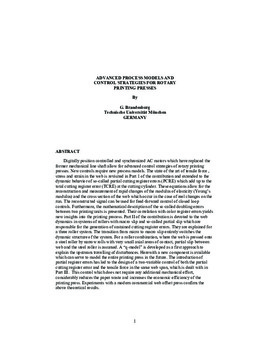| dc.contributor.author | Brandenburg, G. | |
| dc.contributor.other | International Conference on Web Handling (2011) | |
| dc.date.accessioned | 2019-11-11T21:01:19Z | |
| dc.date.available | 2019-11-11T21:01:19Z | |
| dc.date.issued | 2011-06 | |
| dc.identifier | oksd_icwh_2011_brandenburg | |
| dc.identifier.citation | Brandenburg, G. (2011, June). Advanced process models and control strategies for rotary printing presses. Paper presented at the Eleventh International Conference on Web Handling (IWEB), Stillwater, OK. | |
| dc.identifier.uri | https://hdl.handle.net/11244/321980 | |
| dc.description.abstract | Digitally position controlled and synchronized AC motors which have replaced the former mechanical line shaft allow for advanced control strategies of rotary printing presses. New controls require new process models. The state of the art of tensile force , stress and strain in the web is revisited in Part 1 of the contribution and extended to the dynamic behavior of so-called partial cutting register errors (PCRE) which add up to the total cutting register error (TCRE) at the cutting cylinder. These equations allow for the reconstruction and measurement of rapid changes of the modulus of elasticity (Young's modulus) and the cross section of the web which occur in the case of reel changes on the run. The reconstructed signal can be used for feed-forward control of closed loop controls. Furthermore, the mathematical description of the so-called doubling errors between two printing units is presented. Their correlation with color register errors yields new insights into the printing process. Part II of the contribution is devoted to the web dynamics in systems of rollers with macro slip and so-called partial slip which are responsible for the generation of sustained cutting register errors. They are explained for a three roller system. The transition from micro to macro slip entirely switches the dynamic structure of the system. For a roller combination, where the web is pressed onto a steel roller by narrow rolls with very small axial areas of contact, partial slip between web and the steel roller is assumed. A "q-model" is developed as a first approach to explain the upstream travelling of disturbances. Herewith a new component is available which can serve to model the entire printing press in the future. The introduction of partial register errors has led to the design of a two-variable control of both the partial cutting register error and the tensile force in the same web span, which is dealt with in Part III. This control which does not require any additional mechanical effort, considerably reduces the paper waste and increases the economic efficiency of the printing press. Experiments with a modern commercial web offset press confirm the above theoretical results. | |
| dc.format | application/pdf | |
| dc.language | en_US | |
| dc.publisher | Oklahoma State University | |
| dc.rights | In the Oklahoma State University Library's institutional repository this paper is made available through the open access principles and the terms of agreement/consent between the author(s) and the publisher. The permission policy on the use, reproduction or distribution of the article falls under fair use for educational, scholarship, and research purposes. Contact Digital Resources and Discovery Services at lib-dls@okstate.edu or 405-744-9161 for further information. | |
| dc.title | Advanced process models and control strategies for rotary printing presses | |
| osu.filename | oksd_icwh_2011_brandenburg.pdf | |
| dc.type.genre | Conference proceedings | |
| dc.type.material | Text | |
